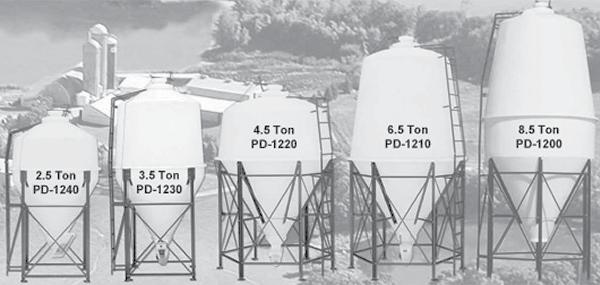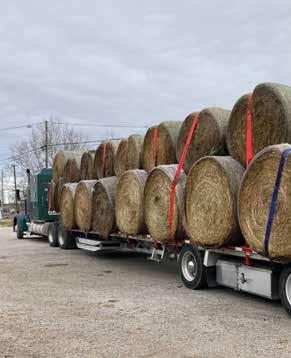
6 minute read
Over $230,000 Raised to Help with Tornado Relief
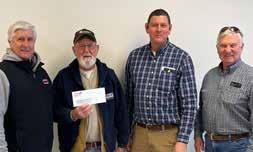
Muhlenberg County receives a donation from the Kentucky Cattlemen's Foundation
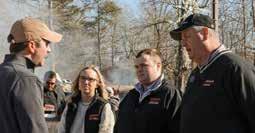
Governor Andy Beshear speaks to KCA staff and leadership at Pennyrile Forest State Resort Park

The Christian County Cattlemen's Association grilled for residents staying at Pennyrile Forest State Resort Park Governor Andy Beshear speaks to volunteers at Pennyrile Forest State Resort Park
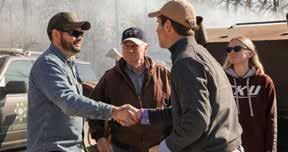

Calloway County receives a donation from the Kentucky Cattlemen's Foundation

Taylor County receives a donation from the Kentucky Cattlemen's Foundation
Nikki Whitaker Kentucky Cattlemen's Association
The Kentucky Cattlemen’s Association, through the Kentucky Cattlemen’s Foundation, received over $230,000 to help farmers in Western Kentucky who had suffered damage following historic tornados across the area. Beginning late on December 10th and continuing into the early hours of December 11th, a violent, long-tracked storm moved across Western Kentucky, producing catastrophic damage in numerous towns, including Mayfield, Princeton, Dawson Springs, and Bremen. The National Weather Service reported that in all, 66 powerful tornadoes created a path of destruction through eight states, many with an EF3 or EF4 rating. It was the deadliest and longest-tracked tornado outbreak Kentucky has seen. Across the Bluegrass, farmers offered a helping hand to neighbors and friends. Within days of the tornados, multiple funding relief efforts were put into place and donations of health supplies, farm supplies and food began pouring into the University of Kentucky Extension Offices. Many local Cattlemen’s chapters grilled steaks and hamburgers for volunteers and residents, and several others delivered hay and volunteered in the debris cleanup. “Through all of this, we are so thankful and see the benefit of a strong network,” said Dave Maples, KCA Executive V.P. “From Cattlemen’s members across the Nation that have donated money, to our county chapters in Kentucky receiving those donations and delivering supplies to cattle producers - the cattlemen’s network is a strong one.” The Kentucky Cattlemen’s Foundation quickly began distributing funds to the impacted areas, working with local Cattlemen’s chapters, ANR Extension Agents, and local farm supply stores. Funds were used to purchase items such as feed bunks and hay rings to distribute to farmers who had lost theirs in the storm. “It is so gratifying to see our county and regional Cattlemen’s groups working so hard to identify specific needs for individual farmers,” said Charles Miller, a KCA past president who helped to raise donations in Jessamine County. “They along with our Ag Extension Agents are the boots on the ground guaranteeing that our funds are serving the greatest and best use.” Many producers have a long road ahead of them as they continue to access the damage done to their property and operations. The Kentucky Cattlemen’s Foundation will continue to take donations to help purchase and deliver supplies where needed. To learn more about the Kentucky Cattlemen’s Foundation, visit the KCA website at www. kycattle.org.
Help Recovering from Natural Disasters
Candace Smith & Lindsay Burley Steptoe & Johnson, PLLC
Recently, devastating tornadoes cut through Western Kentucky, not only destroying homes and communities, but also causing widespread damage to farmlands and livestock. Although this damage was a major blow to both the agriculture and livestock communities, the United States Department of Agriculture (“USDA”) offers a variety of programs that may be able to help farmers that have suffered losses because of natural disasters. One such program is the Livestock Indemnity Program (“LIP”). The LIP provides benefits to eligible livestock owners for livestock injuries or deaths in excess of normal mortality rates caused by eligible loss conditions, such as adverse weather. Eligible adverse weather conditions include tornadoes, as well as earthquakes, lightning, hail, floods, and winter storms, among others. To be eligible to receive LIP payments for adverse weather, owners must have owned the livestock on the day the livestock died and/ or were injured and the livestock must have either died in excess of normal mortality as a direct result of the adverse weather or been injured as a direct result of the adverse weather and sold at a reduced price. Additionally, the livestock must have been maintained for commercial use as a part of a farming operation on the day that they died. If livestock owners meet these criteria, they can receive an LIP payment up to 75% of the market value for livestock that died, as determined by the Secretary of Agriculture. For injured livestock that meet these criteria, the owner can receive the difference between the national payment rate for the livestock category and the amount the owner received for selling the livestock. Another such program is the Emergency Conservation Program (“ECP”), which helps farmers repair damage to farmlands caused by natural disasters. To qualify for ECP funds, the damage to the farmland must have created new conservation problems that, if not addressed, would: • Further damage the land; • Significantly affect the land’s productive capacity; • Represent damage from a natural disaster unusual for the area; • Be too costly to repair without Federal assistance in order to return the land to agricultural production. If farmers wish to utilize ECP funds, the Farm Service Agency Committee will inspect the damage to determine if the land is eligible. Finally, eligible farmers may be able to utilize Emergency Farm Loans through the USDA’s Emergency Loan Program. The Emergency Loan Program is triggered when the Secretary of Agriculture designates a natural disaster, or if the President declares a natural disaster or emergency under the Stafford Act. Farmers who receive Emergency Farm Loans may use the funds to restore or replace essential property, pay production costs associated with the disaster year, pay essential family living expenses, reorganize the farming operation, or refinance certain non-real estate operating debts. To qualify for these loans, farmers must have suffered at least a 30% loss in crop production or a physical loss to livestock, livestock products, real estate, or other property. Many of these programs require farmers and livestock owners to act quickly, which can be difficult in the aftermath of a natural disaster. An attorney can help you examine the available programs, determine your eligibility, and help you apply to ensure you receive the maximum amount of funds needed to rebuild after a natural disaster.
These materials are public information and have been prepared solely for educational purposes. These materials reflect only the personal views of the authors and are not individualized legal advice. It is understood that each case is fact-specific, and that the appropriate solution in any case will vary. Therefore, these materials may or may not be relevant to any particular situation. Thus, the authors and Steptoe & Johnson PLLC cannot be bound either philosophically or as representatives of their various present and future clients to the comments expressed in these materials. The presentation of these materials does not establish any form of attorney-client relationship with the authors or Steptoe & Johnson PLLC. While every attempt was made to ensure that these materials are accurate, errors or omissions may be contained therein, for which any liability is disclaimed.
GREEN RIVER LIVESTOCK
CAMPBELLSVILLE, KY
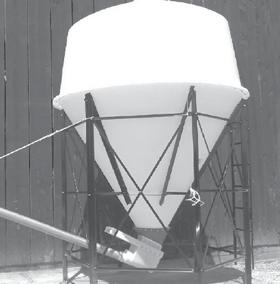
PolyDome Bulk Bins
• Translucent polyethylene allows you to see material level • Made from high-impact, UV stabilized polyethylene • Corrosion resistant • Easy cleaning • Smooth surface reduces bridging • Large, vented filler cap with pull rope for ground access • Sturdy outside ladder • 10 year warranty! BINS IN STOCK & READY TO MOVE!
